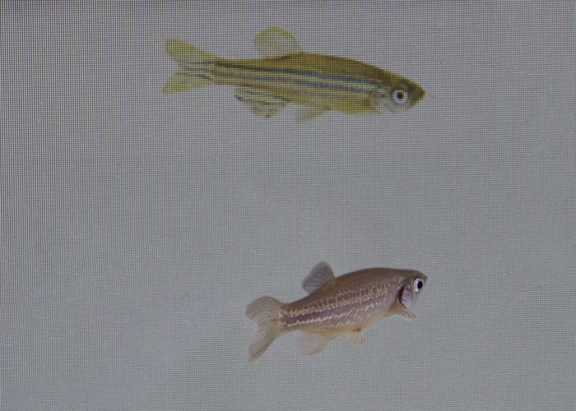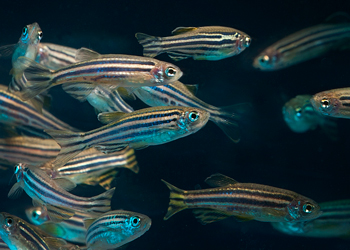
Integrative Behavioural Biology
Rui Oliveira
The group main research interest is the integrative study of social behaviour, which combines the study of proximate causes (gene modules, hormones, neural circuits, cognitive processes) and ultimate effects (evolutionary consequences). In particular, the research group aim to understand how brain and behaviour can be shaped by the social environment and how the cognitive, neural and genetic mechanisms underlying plasticity in the expression of social behaviour have evolved.
Current research questions topics:
Projects
The social environment is a major selective force in the evolution of brain, cognition and behaviour. The interaction with other behavioural agents that characterizes the social domain creates a level of environmental unpredictability and complexity where direct genetic control over the phenotype is outpaced by the rate of environmental change. In this scenario the ability to regulate the expression of social behaviour in order to adapt behavioural output to specific situations in a complex and variable social world (aka social competence), is expected to depend on the evolution of flexible responses that allow the same genotype to produce different behavioural phenotypes, rather than on genetically determined rules controlling fixed traits (e.g., reflexes, fixed action patterns). Hence, social cognition, defined as the neuronal processes concerned with the acquisition, retention and use of information from other individuals, which underlies social competence, is expected to impact the Darwinian fitness of the animal. This rational has led to the proposal of the social intelligence hypothesis, which posits that group living generates the selective forces that drive the evolution of enhanced cognitive abilities. Later on, this hypothesis has been expanded into the social brain hypothesis, which proposes that this socially driven enhancement of information-processing abilities has driven the evolution of brain size. Furthermore, some authors have suggested that these cognitive adaptations for social living depend on a set of domain specific modules that evolved specifically for this purpose and consequently the mechanisms involved in social learning would differ from those of individual learning. Although both hypotheses have received widespread support from comparative studies across different vertebrate taxa, in recent years they have been the focus of much debate. For the resolution of these ongoing debates, an experimental approach that explicitly tests both relevant assumptions and explicit predictions of these hypotheses is needed. In this project key assumptions and predictions of the social intelligence and of the social brain hypotheses will be addressed using experimental evolution for sociality in zebrafish (Danio rerio). Hence, the research proposed here will the first experimental test of the social intelligence and social brain hypotheses and has the potential to clarify the role of sociality on cognitive and brain evolution. In parallel it will further support the development of zebrafish as a much needed vertebrate model organism for translational research in social neuroscience.
The stress response is an adaptive mechanism for the organism to cope with challenging situations (stressors). By increasing circulating levels of glucocorticoids and adrenaline and by activating the sympathetic nervous system animals enter a transient emergency life-history mode that helps them to deal with the event/stimuli that is threatening their homeostasis. Thus an acute response to a stressor is considered to be adaptive. On the other hand, a sustained or very frequent activation of the stress response (chronic stress) is considered to be maladaptive since the costs in terms of its impact on growth, reproduction and immune function out weight the short-term benefits of the response. Therefore, chronic stress has a major impact on the health of both humans and animals and the understanding of the mechanisms that activate the stress response (i.e., that translate the perception of the stress-eliciting event into a response) is crucial to develop ways to mitigate it. Since the 1970’s it became clear that the cognitive appraisal of stressors is a key mechanisms in the activation of the stress response, so that it is not only the intrinsic characteristics of the stressor that trigger a response but rather the evaluation of what that stimuli or event means to that organism at that moment in time. Therefore, the exactly same stressor may elicit different stress responses, depending on the way it is appraised by different individuals or by the same individual at different moments in time (e.g., in different social contexts). The involvement of appraisal in the activation of the stress response also opens the possibility for evaluation biases to occur (i.e., some individuals will consistently evaluate ambiguous stimuli as negative, and others as positive). Thus, cognitive bias in the appraisal process can be a major factor in individual variation in the susceptibility to stress and stress-related diseases. In this project we aim to uncover the genetic pathways and neural circuits involved in cognitive appraisal and in the response to stressors, using zebrafish (Danio rerio) as a model organism. The broader goals of the project are:
1) To develop a behavioural assay to test cognitive bias in zebrafish, and to characterize the behavioural and neuroendocrine profiles of “optimistic” and “pessimistic” individuals. Immediate early genes (IEG) will be used to map brain activation, since they constitute the first gene expression response to the stimulation of a neuron. Therefore, the accumulation of IEG mRNA or protein will be used as a marker of functional neural activity. (TASK 1)
2) To assess if cognitive bias (e.g. pessimistic bias) is mediating the inter-individual variation in the susceptibility to the detrimental effects of stress, using behavioural, systemic (stress axis activity and adult neurogenesis) and cellular (telomere dynamics) read-outs. (TASK 2)
3) To manipulate genetically the neural circuits involved in the cognitive appraisal of stressors (identified in TASK 1) and check its effects on the activation of the stress response. Taking advantage of the large number of GAL4-UAS enhancer trap lines available in zebrafish that have restricted expression in different brain areas (e.g., dorsomedial telencephalon = amygdala; dorsolateral telencephalon = hippocampus), once the area of interest has been identified gain and loss of function can be triggered genetically, and its impact on the stress response assessed. (TASK 3) Although this project is focused on basic biological mechanisms of stress, its outcomes have the potential to have a significant impact in stress management and open the way for the use of zebrafish as a stress model organism in translational biomedical research.
Publications
- Ibukun Akinrinade, Kyriacos Kareklas, Magda C. Teles, Thais K. Reis, Michael Gliksberg, Giovanni Petri, Gil Levkowitz and Rui F. Oliveira (2023) Evolutionarily conserved role of oxytocin in social fear contagion in zebrafish. Science 379:1232-1237
- Ana Rita Nunes, Michael Gliksberg, Susana A.M. Varela, Magda Teles, Einav Wircer, Janna Blechman, Giovanni Petri, Gil Levkowitz and Rui F. Oliveira (2021) Developmental effects of oxytocin neurons on social affiliation and processing of social information. The Journal of Neuroscience 41 (42):8742-8760
- Zegni Triki, Yasmin Emery, Magda C. Teles, Rui F. Oliveira & Redouan Bshary (2020) Brain morphology predicts social intelligence in wild cleaner fish. Nature Communications 11:6423
- Ribeiro, D., Nunes, A.R., Teles, M., Anbalagan, S., Blechman, J., Levkowitz, G., Oliveira, R.F. (2020) Genetic variation in the social environment affects behavioral phenotypes of oxytocin receptor mutants in zebrafish. eLife 9:e56973
- Wircer, E., Blechman, J., Borodovsky, N., Tsoory, M., Nunes, A.R., Oliveira, R.F., Levkowitz, G. (2017) Homeodomain protein Otp affects developmental neuropeptide switching in oxytocin neurons associated with a long-term effect on social behaviour.. eLife 6:e22170
- Faustino, A.I., Tacão-Monteiro, A., Oliveira, R.F. (2017) Mechanisms of social buffering of fear in zebrafish.. Sci Rep. 7:44329
- Oliveira, R.F., Simões, J.M., Teles, M.C., Oliveira, C.R., Becker, J.D., Lopes, J.S. (2016) Assessment of fight outcome is needed to activate socially driven transcriptional changes in the zebrafish brain.. Proc Nat Acad Sci U.S.A. 113:E654-661
- Abril-de-Abreu, R., Cruz, J., Oliveira, R.F. (2015) Social eavesdropping in zebrafish: tuning of attention to social interactions.. Sci Rep. 5:12678
- Teles, M.C., Almeida, O., Lopes, J.S., Oliveira, R.F. (2015) Social interactions elicit rapid shifts in functional connectivity in the social decision-making network of zebrafish.. Proc R Soc B 282:20151099
- Simões, J.M., Barata, E.N., Harris, R.M., O’Connell, L.A., Hofmann, H.A., Oliveira, R.F. (2015) Social odors conveying dominance and reproductive information induce rapid physiological and neuromolecular changes in a cichlid fish.. BMC Genomics 16:114
- Taborsky, B., Oliveira, R.F. (2012) Social competence: an evolutionary approach.. Trends Ecol Evol. 27:679-688
- Soares, M.C., Oliveira, R.F., Ros, A.F.H., Grutter, A.S., Bshary, R. (2011) Tactile stimulation lowers stress in fish.. Nat Comm 2(534):1-4
- Antunes, R.A., Oliveira, R.F. (2009) Hormonal anticipation of territorial challenges in cichlid fish.. Proc Nat Acad Sci U.S.A. 106:15985-15989
- Oliveira, R.F., Carneiro, L.A., Canário, A.V.M. (2005) No hormonal response in tied fights.. Nature 437:207-208


